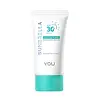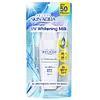What's inside
What's inside
 Key Ingredients
Key Ingredients

 Benefits
Benefits

 Concerns
Concerns

 Ingredients Side-by-side
Ingredients Side-by-side

Water
Skin ConditioningEthylhexyl Methoxycinnamate
UV AbsorberPropylene Glycol
HumectantDiethylamino Hydroxybenzoyl Hexyl Benzoate
UV FilterOctocrylene
UV AbsorberDimethicone
EmollientCetearyl Alcohol
EmollientC14-22 Alcohols
Emulsion StabilisingCyclopentasiloxane
EmollientEthylhexyl Triazone
UV AbsorberGlyceryl Stearate
EmollientPhenoxyethanol
PreservativePEG-100 Stearate
Titanium Dioxide
Cosmetic ColorantAmmonium Acryloyldimethyltaurate/Vp Copolymer
C12-20 Alkyl Glucoside
EmulsifyingDimethicone Crosspolymer
Emulsion StabilisingHydroxyacetophenone
AntioxidantCyclohexasiloxane
EmollientSodium Acrylate/Sodium Acryloyldimethyl Taurate Copolymer
Emulsion StabilisingXanthan Gum
EmulsifyingParfum
MaskingIsohexadecane
EmollientLauryl Polyglyceryl-3 Polydimethylsiloxyethyl Dimethicone
Skin ConditioningPolysorbate 80
EmulsifyingTriethoxycaprylylsilane
Sorbitan Oleate
EmulsifyingButyl Methoxydibenzoylmethane
UV AbsorberEctoin
Skin ConditioningZinc Hydrolyzed Hyaluronate
HumectantGlucosylrutin
AntioxidantPropanediol
SolventZea Mays Starch
AbsorbentHydrolyzed Corn Starch Octenylsuccinate
AbsorbentHydrolyzed Corn Starch
HumectantIsoquercitrin
AntioxidantButyrospermum Parkii Butter
Skin ConditioningCocamidopropyl Dimethylamine
EmulsifyingBuddleja Officinalis Flower Extract
UV FilterPhenylethyl Resorcinol
Antioxidant1,2-Hexanediol
Skin ConditioningLactic Acid
BufferingPalmitoyl Tripeptide-5
Skin ConditioningHydrated Silica
AbrasiveCaprylyl Glycol
EmollientButylene Glycol
HumectantGlucose
HumectantSodium Hyaluronate
HumectantChondrus Crispus Extract
Skin ConditioningHydroxypropyltrimonium Hyaluronate
Sodium Acetylated Hyaluronate
HumectantHydrolyzed Hyaluronic Acid
HumectantHyaluronic Acid
HumectantSodium Hyaluronate Crosspolymer
HumectantHydrolyzed Sodium Hyaluronate
Skin ConditioningPotassium Hyaluronate
Skin ConditioningWater, Ethylhexyl Methoxycinnamate, Propylene Glycol, Diethylamino Hydroxybenzoyl Hexyl Benzoate, Octocrylene, Dimethicone, Cetearyl Alcohol, C14-22 Alcohols, Cyclopentasiloxane, Ethylhexyl Triazone, Glyceryl Stearate, Phenoxyethanol, PEG-100 Stearate, Titanium Dioxide, Ammonium Acryloyldimethyltaurate/Vp Copolymer, C12-20 Alkyl Glucoside, Dimethicone Crosspolymer, Hydroxyacetophenone, Cyclohexasiloxane, Sodium Acrylate/Sodium Acryloyldimethyl Taurate Copolymer, Xanthan Gum, Parfum, Isohexadecane, Lauryl Polyglyceryl-3 Polydimethylsiloxyethyl Dimethicone, Polysorbate 80, Triethoxycaprylylsilane, Sorbitan Oleate, Butyl Methoxydibenzoylmethane, Ectoin, Zinc Hydrolyzed Hyaluronate, Glucosylrutin, Propanediol, Zea Mays Starch, Hydrolyzed Corn Starch Octenylsuccinate, Hydrolyzed Corn Starch, Isoquercitrin, Butyrospermum Parkii Butter, Cocamidopropyl Dimethylamine, Buddleja Officinalis Flower Extract, Phenylethyl Resorcinol, 1,2-Hexanediol, Lactic Acid, Palmitoyl Tripeptide-5, Hydrated Silica, Caprylyl Glycol, Butylene Glycol, Glucose, Sodium Hyaluronate, Chondrus Crispus Extract, Hydroxypropyltrimonium Hyaluronate, Sodium Acetylated Hyaluronate, Hydrolyzed Hyaluronic Acid, Hyaluronic Acid, Sodium Hyaluronate Crosspolymer, Hydrolyzed Sodium Hyaluronate, Potassium Hyaluronate
Water
Skin ConditioningEthylhexyl Methoxycinnamate
UV AbsorberButylene Glycol
HumectantMethylene Bis-Benzotriazolyl Tetramethylbutylphenol
UV FilterPolymethylsilsesquioxane
Cyclopentasiloxane
EmollientTranexamic Acid
AstringentDiethylamino Hydroxybenzoyl Hexyl Benzoate
UV FilterPolysorbate 60
EmulsifyingCetearyl Alcohol
EmollientSilica
AbrasiveBis-Ethylhexyloxyphenol Methoxyphenyl Triazine
Skin ConditioningDecyl Glucoside
CleansingTitanium Dioxide
Cosmetic ColorantPhenoxyethanol
PreservativeTriethanolamine
BufferingAcrylates/C10-30 Alkyl Acrylate Crosspolymer
Emulsion StabilisingHexylglycerin
HumectantDisodium EDTA
Propylene Glycol
HumectantXanthan Gum
EmulsifyingSodium Acetylated Hyaluronate
HumectantWater, Ethylhexyl Methoxycinnamate, Butylene Glycol, Methylene Bis-Benzotriazolyl Tetramethylbutylphenol, Polymethylsilsesquioxane, Cyclopentasiloxane, Tranexamic Acid, Diethylamino Hydroxybenzoyl Hexyl Benzoate, Polysorbate 60, Cetearyl Alcohol, Silica, Bis-Ethylhexyloxyphenol Methoxyphenyl Triazine, Decyl Glucoside, Titanium Dioxide, Phenoxyethanol, Triethanolamine, Acrylates/C10-30 Alkyl Acrylate Crosspolymer, Hexylglycerin, Disodium EDTA, Propylene Glycol, Xanthan Gum, Sodium Acetylated Hyaluronate
 Reviews
Reviews

Ingredients Explained
These ingredients are found in both products.
Ingredients higher up in an ingredient list are typically present in a larger amount.
Butylene Glycol (or BG) is used within cosmetic products for a few different reasons:
Overall, Butylene Glycol is a safe and well-rounded ingredient that works well with other ingredients.
Though this ingredient works well with most skin types, some people with sensitive skin may experience a reaction such as allergic rashes, closed comedones, or itchiness.
Learn more about Butylene GlycolCetearyl alcohol is a mixture of two fatty alcohols: cetyl alcohol and stearyl alcohol. It is mainly used as an emulsifier. Emulsifiers help prevent the separation of oils and products. Due to its composition, it can also be used to thicken a product or help create foam.
Cetearyl alcohol is an emollient. Emollients help soothe and hydrate the skin by trapping moisture.
Studies show Cetearyl alcohol is non-toxic and non-irritating. The FDA allows products labeled "alcohol-free" to have fatty alcohols.
This ingredient is usually derived from plant oils such as palm, vegetable, or coconut oils. There is debate on whether this ingredient will cause acne.
Due to the fatty acid base, this ingredient may not be Malassezia folliculitis safe.
Learn more about Cetearyl AlcoholCyclopentasiloxane, or D5, is a silicone used to improve texture of products and trap moisture.
D5 is considered lightweight and volatile. Volatile means it evaporates quickly after application. Once evaporated, D5 leaves a thin barrier that helps keep skin hydrated.
It is also an emollient. Emollients help soften the skin and prevent water loss. Silicones create a silky texture in products. D5 helps other ingredients become more spreadable.
Studies show D5 is safe to use in skincare products. We recommend speaking with a skincare professional if you have concerns.
Learn more about CyclopentasiloxaneDiethylamino Hydroxybenzoyl Hexyl Benzoate (DHHB) is a chemical UV-A absorber. It is formulated for high UVA protection (320-400 nm).
DHHB is well-liked for:
DHHB has been approved by the EU, Japan, Taiwan, and South America for use up to 10%. Unfortunately, it has not been approved for use in the US or Canada due to slow regulatory processes.
This ingredient is soluble in oils, fats, and lipids.
Learn more about Diethylamino Hydroxybenzoyl Hexyl BenzoateEthylhexyl Methoxycinnamate is an organic compound that provides UVB protection. It often goes by the more common name of octinoxate. It is created from methoxycinnamic acid and 2-ethylhexanol.
Ethylhexyl Methoxycinnamate absorbs UVB rays with wavelengths between 280-320 nm. UV absorbers protect your skin by using chemical reactions to convert UV rays into heat and energy.
UVB (290-320 nm) rays emit more energy than UVA rays. They are capable of damaging DNA, causing sunburns and are thought to be linked to skin cancer.
The state of Hawaii has banned sunscreens containing octinoxate due to its potential impact on coral reefs. More research is needed to bridge gaps in this research. The European Union allows higher levels of octinoxate in sunscreens than the US and Australia.
Ethylhexyl Methoxycinnamate is oil soluble. It is not stable and may lose efficacy when exposed to sunlight.
Learn more about Ethylhexyl MethoxycinnamatePhenoxyethanol is a preservative that has germicide, antimicrobial, and aromatic properties. Studies show that phenoxyethanol can prevent microbial growth. By itself, it has a scent that is similar to that of a rose.
It's often used in formulations along with Caprylyl Glycol to preserve the shelf life of products.
Propylene Glycol is an odorless, colorless liquid. As a humectant, it helps skin retain moisture. It also aids in delivering active ingredients.
Another role of this ingredient is preventing a product from melting or freezing. Propylene glycol also adds antimicrobrial properties to a product, elongating product lifespan.
This ingredient is considered an organic alcohol and commonly added into both cosmetics and foods.
Those with sensitive skin or conditions may develop a rash when using this ingredient.
Learn more about Propylene GlycolSodium Acetylated Hyaluronate is a type of Hyaluronic Acid.
Hyaluronic Acids help moisturize, soothe, and protect the skin.
Read about common types of Hyaluronic Acid here:
Sodium Hyaluronate
Hydrolyzed Hyaluronic Acid
Hyaluronic Acid
Titanium dioxide is a mineral UV filter widely used in sunscreens and cosmetics.
It is one of only two UV filters officially classified as “mineral” by regulatory agencies, the other being zinc oxide.
Titanium dioxide provides broad-spectrum protection mostly in the UVB and UVAII range, with some protection in the UVAI range.
While its UVA protection isn’t as strong as zinc oxide’s, the difference is minor.
A common myth is that mineral UV filters reflect UV light. However, modern research shows titanium dioxide absorbs UV radiation like chemical filters (~95% absorption & 5% reflection).
Thanks to its non-irritating nature, titanium dioxide is suitable for sensitive, acne-prone, or redness-prone skin. It is unlikely to cause "eye sting" like other sunscreen ingredients.
A major drawback of this ingredient is its white cast and thick texture. This is why mineral sunscreens often leave a white cast and are less cosmetically elegant than chemical/hybrid sunscreens.
To improve white cast and spreadability, micronized or nano-sized titanium dioxide is often used.
There are ongoing concerns surrounding nano-titanium oxide's impact on marine ecosystems.
There is no conclusive evidence that any form of titanium oxide (or any other sunscreen ingredients) will cause harm to marine ecosystems or coral reefs. The science is still developing but many consumers are keeping a close eye on this issue.
Please note, many destinations have reef-safety sunscreen rules. For instance, the U.S. Virgin Islands advises all visitors to use non-nano mineral sunscreens.
Nano mineral sunscreens once raised safety concerns about absorption into skin.
Extensive research has shown that they do not penetrate healthy or damaged skin; they remain safely on the surface and the top layer of dead skin (stratum corneum).
You'll likely find titanium dioxide bundled with alumina, silica, or dimethicone. These ingredients help make titanium dioxide highly photostable; this prevents it from interacting with other formula components under UV light.
Learn more about Titanium DioxideWater. It's the most common cosmetic ingredient of all. You'll usually see it at the top of ingredient lists, meaning that it makes up the largest part of the product.
So why is it so popular? Water most often acts as a solvent - this means that it helps dissolve other ingredients into the formulation.
You'll also recognize water as that liquid we all need to stay alive. If you see this, drink a glass of water. Stay hydrated!
Learn more about WaterXanthan gum is used as a stabilizer and thickener within cosmetic products. It helps give products a sticky, thick feeling - preventing them from being too runny.
On the technical side of things, xanthan gum is a polysaccharide - a combination consisting of multiple sugar molecules bonded together.
Xanthan gum is a pretty common and great ingredient. It is a natural, non-toxic, non-irritating ingredient that is also commonly used in food products.
Learn more about Xanthan Gum